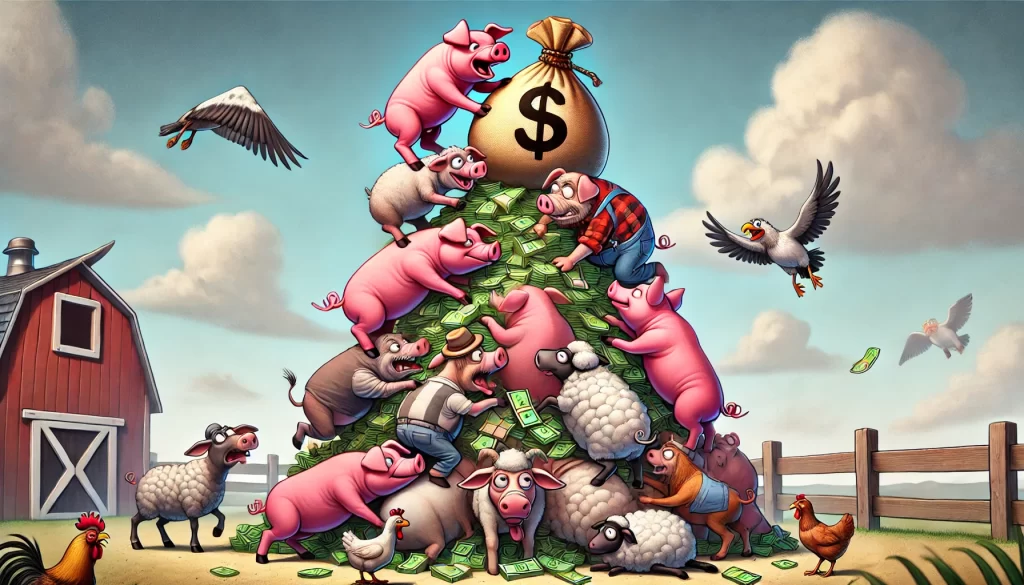In George Orwell’s Animal Farm, the pigs begin as fellow workers in the collective fight against oppression, only to rise to positions of authority and wealth, ultimately indistinguishable from the tyrants they sought to overthrow. A similar pattern can be observed in the careers of several prominent Australian union and political leaders. These leaders start as humble functionaries within the union movement, working their way up the ladder of influence and wealth—often using their worker-based platforms to transition into high-paying political and corporate roles. This blog will explore the rise of three key figures: Bill Shorten, Greg Combet, and Daniel Andrews, revealing the path from union advocate to elite insider, all while leveraging the support and contributions of workers.

Bill Shorten: From Union Footsoldier to University Leader
Bill Shorten’s ascent did not begin at the top of the union hierarchy. After completing his law degree, Shorten’s early career saw him working as a trainee lawyer and an electorate officer for Labor MP Neil Cole. His formal entry into the union movement began when he became a union organiser for the Australian Workers’ Union (AWU) in 1994. From there, he quickly rose through the ranks due to his effectiveness in advocating for worker interests, particularly in securing better pay and conditions for AWU members.
By 2001, Shorten had become the National Secretary of the AWU, a role that solidified his power and influence within the union movement. His union leadership eventually propelled him into federal politics, where he became a key figure in the Labor Party, serving as Minister for the NDIS and Government Services and later as Opposition Leader. As of 2025, he is transitioning to the prestigious role of Vice-Chancellor of the University of Canberra where he will enjoy significant personal wealth and influence, a far cry from his early days as a worker’s representative.
Greg Combet: The Steady Climb from Union Activism to Corporate Power
After studying mining engineering, Combet joined the Australian Council of Trade Unions (ACTU) as a research officer in 1993. His early career focused on gaining technical expertise and building a reputation as a tireless advocate for workers. Combet’s big break came when he was promoted to the position of Assistant Secretary of the ACTU, where he played a pivotal role in the campaign against the Howard Government’s WorkChoices industrial relations reforms.
In 1999, he became Secretary of the ACTU, a role that cemented his status as one of the most influential figures in Australia’s labor movement. Following his successful stint in union leadership, Combet transitioned into federal politics, serving as a Minister in various portfolios. Post-politics, Combet moved into lucrative board roles, including Chair of IFM Investors and Industry Super Australia. These positions provide substantial financial rewards and demonstrate how union activism can serve as a launchpad for corporate and political success, far removed from the working-class roots of his early career.
Daniel Andrews: From Party Functionary to Business Elite
Daniel Andrews’ journey to wealth and influence also began in the Labor Party’s lower ranks. After completing his Bachelor of Arts, Andrews entered politics as an electorate officer for federal MP Alan Griffin. From there, he worked his way up in the Labor Party, becoming Assistant State Secretary before being elected to the Victorian Legislative Assembly in 2002. His early career focused on party organising and backroom roles, but his ambition soon saw him rise to the position of Premier of Victoria in 2014.
Andrews’ political career has been marked by ambitious infrastructure projects and progressive reforms, but also controversy and accusations of cronyism. Now, after his resignation as Premier, Andrews is reportedly setting up a China-focused business, capitalising on the political relationships he built during his time in office. While details of his new venture are still emerging, it is clear that his career trajectory, much like those of Shorten and Combet, shows a consistent rise from party and union functionary to elite businessman, far removed from the working-class origins of his political narrative.
The Ladder of Wealth Creation: How Union and Political Leaders Rise to Wealth
The stories of Shorten, Combet, and Andrews are emblematic of a broader trend within the union and political spheres in Australia. Their careers follow a familiar pattern:
- Start in Union or Party Apparatus: All three figures began their careers in junior or mid-level roles within unions or political party structures. Their early work focused on advocacy, party organisation, or technical expertise related to worker representation.
- Rise Through Union Leadership or Political Ranks: By building connections within the union movement or political party, they were able to ascend to positions of significant power. This not only allowed them to shape national policy but also to build personal influence.
- Transition to Lucrative Roles: Upon leaving formal political or union roles, these leaders leveraged their experience and connections to secure high-paying positions in academia, corporate boards, or private business. This final step in the ladder results in substantial personal wealth accumulation, often at odds with the working-class rhetoric that propelled them to prominence.
Conclusion: Wealth Creation on the Backs of Workers
The path from union functionary to political leader and eventually to corporate or academic elite represents a clear ladder of wealth creation, often cynically constructed on the backs of the workers these leaders once claimed to represent. While the average worker sees their union dues as an investment in securing better wages and conditions, the union leaders at the top of the pyramid often parlay their positions into personal financial success. Just as the pigs in Orwell’s Animal Farm transformed from comrades to oppressors, Australia’s union leaders often rise to wealth and influence far removed from the working-class struggles that first empowered them.
For the workers at the bottom, the ladder is largely invisible, but for those at the top, it is a reliable pathway to personal enrichment. The contradiction between the rhetoric of worker advocacy and the reality of elite wealth creation is one that increasingly defines Australia’s labor movement.